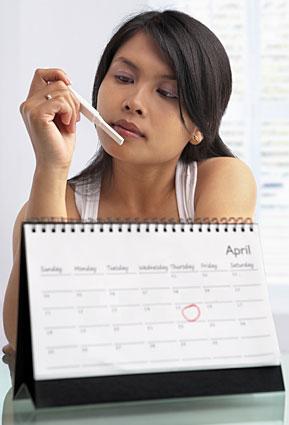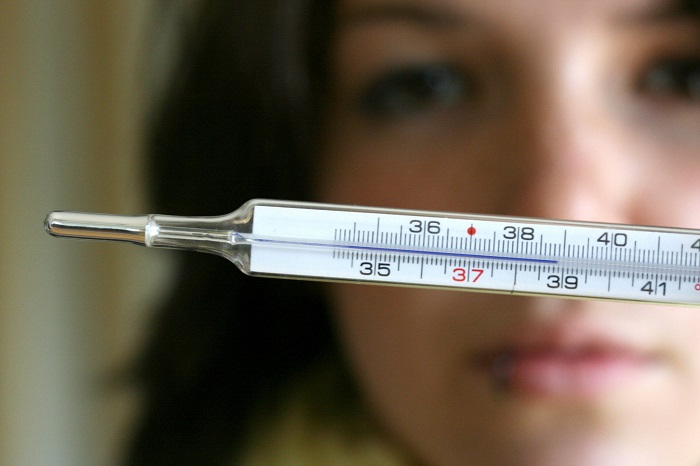How to calculate ovulation period. An example of how to calculate ovulation in women. Special methods for calculating the time of ovulation.
Ovulation (lat. ovum - egg) is the process of release of a mature egg, capable of fertilization, from the ovary into the abdominal cavity.
The timing of this process is strictly individual for each woman, they can be correctly determined only as a result of a special calculation.
Such calculations are designed to immediately solve a complex of problems:
Ovulation Signs - How can you tell when you are ovulating?
All about ovulation, ovulation signs, ovulation signs, ovulation symptoms, ovulation cycle and yours. Want to know more about ovulation? Ovulation is the development and release of an egg from a woman's ovary. You can also learn to pick up signals from your body that tell you when you are about to ovulate.
Watch for changes in cervical mucus. You can detect ovulation by watching for changes in your cervical mucus, which is a great indicator of your phase. Your cervical mucus increases in volume and changes structure as your monthly cycle progresses. At first menstrual cycle mucus is sparse, cloudy, sticky, and thick, and when you ovulate, this fluid becomes more copious, clear, and slippery. The fluid consistency when you ovulate is described as the consistency of raw egg white.
- help women suffering from infertility to identify the most favorable child;
- adjust the methods of treatment aimed at eliminating various;
- find out in what period maximum discretion will be required for those women who, for reasons, cannot use reliable means - oral contraceptives or a spiral.
Of course, it is very important to find out how to calculate ovulation in women most exact method. After all, the chances of probable conception, long-awaited and planned, in the most favorable period for a woman, directly depend on this.
Special Methods for Calculating Ovulation Time
Check for other signs of ovulation. Some women experience ovulation. They feel like abdominal pain or discomfort and usually only last a few hours. Ovulation Predictor Kit - These kits are available in pharmacies and supermarkets. They detect luteinizing hormone, which accumulates at the onset of ovulation. The kit tells you when to start testing based on middle length your cycle. Testing usually takes place within five days.
How long does an egg live after ovulation
Remember that it is easy for some women to tell when they are ovulating using a combination of the above ovulation signs, while others never figure it out. Here are the times you should be most fertile during the following months.
1. Calendar method
Every woman should keep a calendar of her cycles, in which it is necessary to mark the dates of the beginning and end of menstruation. Such a calendar not only helps to determine favorable days, but also, in general, to control the slightest deviations in health.
How many days before menstruation usually? As a rule, this process occurs about two weeks before the start of a new period.
It may take time - be patient. It may take up to a year for you to become pregnant. To maximize your chances of getting pregnant, have sex in the days leading up to and around ovulation because sperm can live 3-5 days inside you, but the egg only lives for one day. This is known as your fertile window.
How accurate are ovulation predictions?
Twenty-four hours after ovulation, the unfertilized egg is not viable and you will not get pregnant in this cycle. The more regular your cycle is, the more accurate the calendar will be because it is based on your past menstrual patterns. However exact time ovulation can vary from month to month, even in women with regular cycles.
If, for example, the cycle lasts 21 days, menstruation lasts a week, it can occur immediately after menstruation. This process has big influence and taking various hormonal drugs.
It is impossible to completely exclude the possibility of the release of a mature egg even a few days after the end of menstruation.
When ovulation occurs after menstruation, women with very short cycles and long periods may become pregnant. As early as 3 days after menstruation, ovulation can occur. To receive a fertilized egg, the endometrium may already grow in the uterus.
Ovulation during menstruation
Use the physical signs of ovulation to help you predict when you are most fertile, including. There are also home kits you can use to predict ovulation and find your fertile window. One type of test measures luteinizing hormone - the hormone that controls ovulation - in your urine. Other ovulation tests can detect changes that occur in your saliva in the days leading up to ovulation.
It is important to note that the ovulation calendar is a tool to help women get pregnant. This is not an appropriate way to prevent pregnancy. 
Conception is defined as the onset of pregnancy or the exact moment an egg is fertilized. Logically, it looks like your date and date of dating will be the same. This may be true, but since sperm can live inside a woman's body for up to three days, conception can occur up to three days after intercourse, depending on when you ovulate.
Ovulation during menstruation
In some women who suffer from irregular menstrual cycles, menstruation comes at different time and with very different frequency: they may occur only once in a period of several months, and they may even begin many times within only one month. Ovulation during menstruation in this situation is quite possible.
How and when to determine the day of ovulation with an accurate method?
At this time, medical technology has no way of indicating the exact date of conception; It is almost always unknown. Conception must occur within 24 hours of ovulation when you release an egg for fertilization. Determining the date of your concept.
While you may not be able to pinpoint exactly when a concept came about with complete accuracy, there are several methods you can use to help you figure it out. All it takes is a little research and knowledge about your body. Calculation concept based on ovulation.
Ovulation is a very important period in a woman's life. It is associated with the maturation and release of the egg, followed by its fertilization or rejection by the body along with the endometrium. The correct course of this process indicates a normal hormonal background, the absence of various diseases of the internal genital organs and readiness for childbearing.
You can't get pregnant until you ovulate, so if you're planning your ovulation date, you can estimate when conception occurred. If you have a normal 28-day cycle, conception usually occurs about two weeks after the first day of your last period. Many women do not have an accurate 28-day cycle and do not ovulate 14 days after the first day of their last period. If you plan your cycle and know how many days between periods, you should be able to determine ovulation.
When is the time for ovulation
If your cycle is over 28 days, take number 14 and add an extra day for each day your cycle is over 28 days. If you have a 30 day cycle, you ovulated about 16 days after the first day of your last period. If you have a 35 day cycle, you ovulated about 20 days after the first day of your last period.
1
Video on how to determine ovulation
The reproductive sphere is a very delicate and serious mechanism. Each representative of the weaker sex is individual, so the doctor, based on the tests and the collected history, cannot always establish an accurate diagnosis and find out when menstruation or ovulation occurs. This can be helped by a correctly drawn up basal temperature chart, from which the moment of ovulation will be accurately visible.
If your cycle is less than 28 days, take the number 14 and subtract a day for each day your cycle is shorter than 28 days. If you have a 24 day cycle, you ovulated about 10 days after the first day of your last period. If you have a 26 day cycle, you ovulated about 12 days after the first day of your last period.
An ultrasound can give you a conception date within one week based on your gestational age. If you know or suspect your due date, you may notice that it doesn't match how many weeks you have. This is because gestational age is not measured by the date of conception, but by the date of your last period. you have a regular cycle and it lasts 6 weeks, your baby is only 4 weeks old. The ultrasound technician can measure your baby's size and use those measurements to give you a reasonably accurate measurement when you're wondering.
This period in the life of any girl is associated with the maturation and release of the egg from the ovaries into the fallopian tubes, where it is further fertilized, as well as fixed on the uterine mucosa. The ability of a woman to bear a fetus and give birth depends on the correct course of the process. healthy child, so it should be approached very carefully.
Unfortunately, there are no signs of conception on your conception date. You may suspect that you are pregnant, especially if you are tracking your ovulation cycle and are trying to conceive. About two weeks after conception, if you have a regular cycle, you may notice signs early pregnancy. These include missed periods, breast tenderness, increased urination, nausea, sensitivity to food or smells, exhaustion, and mood swings. However, many women experience several early symptoms pregnancy.
If you are in doubt if you are pregnant, take home test for pregnancy. While it may be interesting to date your conception to know the exact moment your child started growing, knowing that this is not a medical necessity. Your due date is usually determined from the first day of your last menstrual period and is only rough estimate when the baby is born. Understanding when conception may occur can help you in your quest to get pregnant, but will not affect the outcome of your pregnancy.
Can be produced in the following ways:
- Special programs and on a computer and smartphone;
- Empirically (with daily measurement of basal temperature);
- Accurate methods (using ultrasound and special tests).
Thus, a woman can find out when ovulation occurs using different methods. All these methods have their advantages and disadvantages, as well as the degree of accuracy. That is why any girl who cares about her health and reproductive sphere should choose the most suitable option for herself.
For couples trying to conceive, knowing your menstrual cycle is extremely important. This is where natural cycles come in. The app will tell you when you are most fertile and give you a very accurate prediction of when you will ovulate by analyzing your temperature and cycle.
This way you can get under the sheets with your loved one when it's the right time and get to know your body while you're at it. The day of ovulation is when the egg is released from the ovary and is ready to be fertilized by sperm. The egg lives up to 24 hours. Because sperm can survive up to 5 days inside you, this creates a 6-day fertile window, which is the time period when a woman can get pregnant. However, the chance of conception increases dramatically if you have intercourse in the three days leading up to and including ovulation.
2
To calculate the day of ovulation, many girls are now helped by applications installed on their phones and computers. To determine the exact value, they require several data - the day of the onset of menstruation and the approximate duration of the cycle. Based on these values, the program builds a menstruation schedule and calculates the time of a woman's ovulation.
Calendar view: red colors indicate how fertile you are, the darker the red, the more fertile you are. good first The first step to getting to know your cycle and finding your fertile period is to know how long it is on average. The first day is the first day of the menstrual cycle, and the last day is the day before the next period. General rule- The longer your cycle, the later your ovulation day will be.
However, these days are never set, especially for us irregular ladies. Have you ever noticed that your period comes earlier or later than usual? Or ever wondered why your pregnancy test is negative even though you are not having a period? Well, that's because a woman's follicular phase, the first half of your cycle before ovulation, often varies - my follicular phase can vary up to 6 days! All of this means that your ovulation day can vary from cycle to cycle, so it's good to keep track of your temperature and cycle with natural cycles.
This method allows the girl to find out, or, conversely, determines favorable days for unprotected intercourse. However, the accuracy of this method is questioned by qualified specialists, since the female body is complex and individual. In addition, the period of the menstrual cycle depends on many factors - the external environment, emotional state and health.
Another popular question women ask about their cycles is "When will I have my period?" Or “When should I take a pregnancy test?”. This is the barren stage of your cycle and is pretty consistent. This means that it useful characteristic menstrual cycle, which can be used to determine when you are likely to get your period, which is approx. 2 weeks after ovulation. However, you should be aware that the length of the luteal phase can also be very individual and can vary from 6 to 18 days, so you should never assume that your ovulation day was two weeks before.

3
A simple method that is associated with a change in basal temperature will help a woman calculate the day of ovulation. In this case, the calculation must be made every morning using thermometers. This method will require a lot of patience, time and scrupulousness, since it will take at least two to three months of daily measurement to get an accurate schedule.
Instead, it is much safer to calculate ovulation with reliable birth rates such as sets of temperature and ovulation predictions, just like we do. Know when your period is coming. Period trackers based on the rhythm method assume you are regular. Their main purpose is to tell you roughly when you can expect your next period, which will be around the same time each month, as they don't detect ovulation or variations from your data.
We understand that pregnancy is one of the most wonderful feelings in the world, as well as intimacy with your partner. Will you try to conceive or would you like to buffer it on this moment, an ovulation calculator can help you do both.
It is possible to calculate correctly the basal temperature only with the help of a mercury thermometer in oral cavity, vagina or rectal opening. In this case, the measurement must be carried out immediately after waking up, without getting out of bed, otherwise you can get an incorrect result. Also, with a regular calculation of BT, it is important not to make sudden and active movements, you can’t have sex and other things before going to bed. physical activity. This method is old, so it is not suitable for every girl. Other more pleasant and simple methods for determining the time of ovulation will help save time, effort and nerves.

During maturation and release of the egg basal body temperature increases, and before menstruation decreases again. This indicates the correct hormonal background, the absence of various diseases of the internal female genital organs and other problems.
Therefore, any representative of the weaker sex should know when she ovulates. This will help her not only plan the desired pregnancy, but also find out the safest days for unprotected intercourse.
4 How and when to determine the day of ovulation with an accurate method?
Video about the definition of ovulation
The period of maturation and release of the egg from the ovaries is an extremely complex process, which is influenced by many factors - hormonal background, external environment And climatic events, psychological state, infectious diseases and other serious pathologies. That is why any girl should know how to calculate the day of ovulation.
Doing this on your own can be very difficult and almost impossible. The way out in this situation is:
- ultrasonography internal organs women;
- special tests.
In the process of ultrasound, the doctor controls the time of maturation of the ovary and can accurately determine the period of release of the egg. This method is mainly used in in vitro fertilization and the treatment of certain diseases.
Another simple method are special tests that women can buy at any pharmacy. They look like simple litmus tests, but they cost more than a regular pregnancy test. This is the most affordable and popular way to determine the day of ovulation, which does not require a woman special training, extra time and effort. The test reacts to luteinizing hormone, which appears during the release of the egg - this explains its high accuracy.




